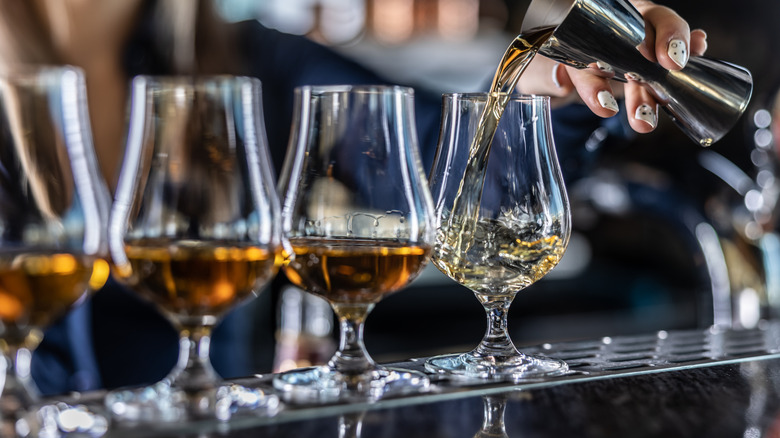What It Means To 'Nose' A Glass Of Bourbon, And Why It's So Important
We may receive a commission on purchases made from links.
Tasting bourbon can be as simple or as involved as you make it. Pouring a small amount of your favorite one into a whiskey or bourbon glass and slowly sipping it is still enjoyable, but to avoid making any common whiskey-tasting mistakes, you should follow all the right steps. This includes nosing the bourbon, a smelling technique designed to help you decipher its aromas.
To nose the bourbon properly, you should have the right tasting glass, though it's not an absolute requirement. A Glencairn Glass — a wide-bottomed glass with a narrow top – is the best option because that narrower top means the aroma is pushed more directly toward your nose, concentrating the scent better. You can buy a set of authentic Glencairn Glasses on Amazon. From the moment you pour the bourbon you get its scent. But, to properly nose a bourbon glass, gently swirl it around in the glass first to release those notes. Then, take a relaxed whiff with the glass close to your nose and let the scent fully infiltrate your senses.
Why the 'nose' step of bourbon tasting is important
While it's called a bourbon tasting, the "tasting" process also encompasses the smell since understanding a bourbon's aroma is an equally important step in absorbing its flavor profile. As you taste the bourbon, your nose simultaneously smells it and its scent heavily influences its flavor notes. Absorbing the flavor entirely helps you know if it's one of those bourbons you should leave on the shelf or if it's worth the spend.
You can certainly inhale the bourbon through your nose, but some experts suggest a technique known as retronasal smell, a type of smell that scientifically ties it to taste. To do this, inhale the bourbon through your mouth, then hold your breath as the smell travels back into your nasal cavity. You can do this as you sip the bourbon, too; the idea is that your nose absorbs the smell, as do your taste buds. This technique is commonly used when inhaling cigars or tasting wines and helps the nose and mouth work together to give you the best understanding of flavor.

